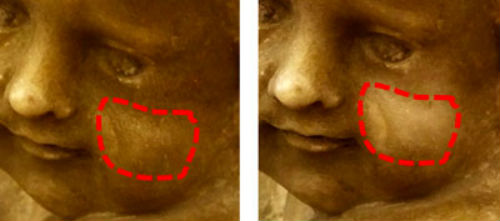|
ARTE E CIÊNCIA
Nanotechnology for the preservation of cultural heritage. Environmental factors such as pollution, weathering, or mechanical stress result in the deterioration of historical artwork. Wall paintings and frescoes, for instance, lose their original cohesion over time and layers of dust, candle smoke, and oily grime cover and dull the original artwork. Often, the removal of these undesired coatings is required not only for aesthetic reasons but also to prevent damage in the long-term, e.g. flaking of the surface layers. "Emulsions are widely used in cleaning protocols and they are particularly attractive in the conservation of Cultural Heritage," Professor Giuseppe Lazzara from the Università degli Studi di Palermo, tells Nanowerk. "The main advantage of oil-in-water emulsions is the possibility to obtain a controlled cleaning, minimizing the use of organic solvents for the removal of hydrophobic coherent layers onto a surface. The use of emulsions combines the detergency and surface active properties of the surfactant with the synergistic solving action of the organic solvent." Typically, microemulsions are engineered and preferred to emulsion due to their thermodynamic stability. The first successful use of microemulsion to art conservation was reported in 1995 for the frescoes by Masaccio and Masolino (Brancacci Chapel in Florence, Italy). The main advantage of these colloidal systems is the possibility to obtain a controlled cleaning, minimizing the use of organic solvents for the removal of hydrophobic coherent layers onto a surface with the synergistic solving action of the organic solvent and surface active feature of the stabilizing agent. In new work, reported in ACS Applied Nano Materials ("Pickering Emulsion Gels Based on Halloysite Nanotubes and Ionic Biopolymers: Properties and Cleaning Action on Marble Surface"), a research team led by Lazzara and Professor Rawil Fakhrullin (Kazan Federal University, Republic of Tatarstan, RF), proposes a new strategy for designing Pickering emulsion based on halloysite nanotubes and exploring chitosan and pectin as thickener additives.  Confocal imaging of Pickering emulsion in pectin gel (left) and sketch representation of a oil droplet stabilized by halloysite nanotubes (right). (Image courtesy of the researchers)
His and Fakhrullin's teams collaborate on projects related to cultural heritage conservation. They recently published a book on this topic: Nanotechnologies and Nanomaterials for Diagnostic, Conservation and Restoration of Cultural Heritage (Micro and Nano Technologies). There are three main requirements for the specific features of materials that are to be applied in Cultural Heritage restoration: 1) Controlled cleaning, meaning that the operator should be able to apply the formulation on specific controlled surfaces, minimizing diffusion in all directions (penetration and surface spreading); and 2) the cleaning efficacy/strength should be controllable by application time to tailor the formulation uses in different places of the artwork; and 3) the used materials and protocols should minimize negative environmental impact. The team's novel and facile strategy to prepare hydrogel containing oil-in-water stable emulsion offers an alternative route to prepare formulations with high performance and based on sustainable materials for the controlled cleaning and preservation of stone-based artworks. "Our innovative hydrogel exploits the stabilizing effect of halloysite nanotubes in the formation of oil-in-water emulsion," Lazzara explains. "The combination of halloysite Pickering emulsions with ionic biopolymers allowed us to obtain biocompatible gel materials with a high affinity toward organic compounds forming the dirty layer on solid surfaces exposed to atmospheric agents." "In addition" he adds, "we detected that the presence of the biopolymer affects the morphological and thermodynamic characteristics of the Pickering emulsions on dependence of the specific electrostatic interactions with the halloysite surfaces." The researchers demonstrated the performance of their nanostructured gel for effective and controlled cleaning applications in a cleaning test on the funeral marble monument of Placido Caruso located in the church of Madre Maria SS. Assunta in Sicily.  Application of the Pickering in Pectin gel system on cherubs of the funeral monument of Placido Caruso (Polizzi Generosa, Italy). Left hand side: Before cleaning. Right hand side: After cleaning. In the dashed box, the cleaning region. (Reprinted with permission by American Chemical Society)
"Pickering emulsions in biopolymer based gel phase can be considered as promising systems for the cleaning of solid surfaces," Lazzara concludes. "Within the Cultural Heritage field, this capacity can be exploited to develop novel and safe protocols for the conservation of artworks. Additionally, the Pickering emulsion gels could be loaded with organic molecules that possess specific functionalities, including antimicrobial, antioxidant and anticorrosive compounds." He adds that the gel systems might be used for a controlled and prolonged release of the functional molecules. On this basis, the loaded Pickering emulsions in biopolymer gel could act as efficient carriers, which can be an interesting perspective for technological, pharmaceutical and medical purposes. By Michael Berger. NW. Posted: May 08, 2019. Assuntos Conexos: Non-destructive nanotechnology diagnostics for artwork restoration.
|
||||||||||||||||||||||||